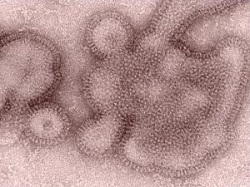 |
| H3N2 flu strain magnified--Courtesy of CDC/Dr. Michael Shaw, Doug Jordan |
Last year's flu vaccine didn't provide as much coverage as scientists had hoped, and now researchers from Canada's British Columbia Centre for Disease Control think they have discovered the culprit.
Historically, inadequate flu vaccine effectiveness has been linked to evolutionary drift in circulating viruses. But the British Columbia research team found that mutations in the H3H2 virus occurred when a common strain of the virus chosen for the manufacture of a vaccine was modified. Although this so-called reference strain was initially well-matched to the virus it was intended to protect against, it had to be altered to grow better in chicken eggs to produce the vaccine. It was at this stage in the vaccine-making process that the misstep occurred.
Evolutionary drift accounts for why flu vaccines are reformulated every flu season. Flu viruses can change by antigenic drift, small changes in the virus that happen continually over time, and antigenic shift, or an abrupt major change in the influenza A virus.
The researchers, led by Dr. Danuta Skowronski, found that in Canada, Europe and the U.S., the 2012-2013 seasonal flu vaccine was about 50% effective overall but only 41% effective against H3N2, a subtype of the seasonal influenza A virus that accounted for most flu cases last season.
Against the 2009 H1N1 virus, commonly known as swine flu, vaccine effectiveness was 59%. For influenza B, which also carries seasonal strains but evolves slower than influenza A, vaccine effectiveness was 68%.
The World Health Organization flagged the mutations in the egg-adapted strain and recommended using an alternate egg-adapted virus for last season, without changing the original reference strain. The scientists said that three mutations inside the egg-adapted strain were the likely reason for suboptimal coverage of last year's flu vaccine.
The findings underscore the importance of matching the egg-adapted virus as well as understanding how specific mutations affect the effectiveness of vaccines.
Few H3N2 flu cases have been detected in North America this flu season, making it difficult for researchers to measure this year's vaccine effectiveness against the H3N2 strain.
- read the study in PLOS ONE
- get more from the University of Minnesota's Center for Infectious Disease Research and Policy